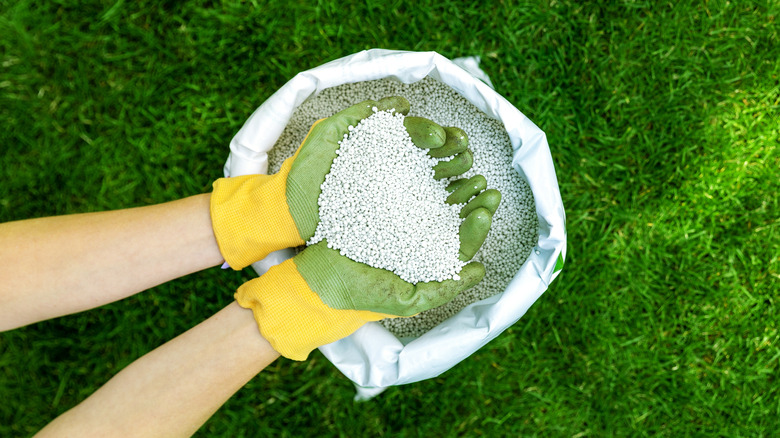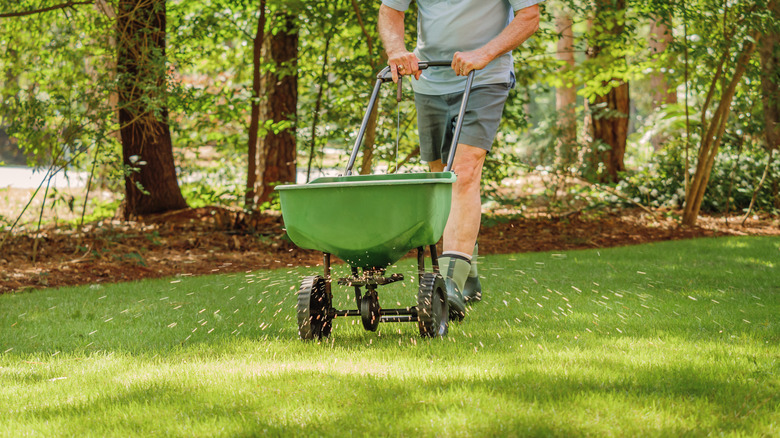The Eco-Friendly Lawn Fertilizer Tiktok Swears By For Greener Grass
Maintaining a green lawn isn't for the faint of heart. It takes time, dedication, money, and hard work. Additionally, green-grass lawns aren't very eco-friendly, as they're essentially deserts for pollinators and other wildlife. Pesticides and fertilizer runoff have also been proven to leach into groundwater and waterways, leading to algal blooms and ecological devastation. Now that this information is becoming widely known, people are switching to organic, more natural fertilizers and considering their lawn's ecological impact.
A recent TikTok trend has demonstrated how homeowners can keep their grass lawns green, lush, and healthy using an organic, slow-release fertilizer called Milorganite. While there are a few natural ways to keep your lawn green, Milorganite is particularly sustainable, as it's made from upcycled byproducts. There are a few factors to note, however, before applying this fertilizer to your lawn. Also, squeamish readers beware, as the manufacturing process is a bit unexpected and, shall we say, unorthodox.
What is Milorganite?
Milorganite is a slow-release fertilizer made from treated sewage sludge sourced from the Milwaukee Metropolitan Sewage District's wastewater treatment plants. While this probably strikes you as gross, the way the fertilizer is upcycled into a new product is part of what makes it a sustainable alternative to synthetic varieties.
Sewage sludge contains many leftover nutrients that plants need, like nitrogen, phosphorous, and other organic matter that would otherwise be discarded. To help break down the biosolids in wastewater, microbes are added to digest the water's nutrients, making them bioavailable. Microbes play a significant role in soil health, as well as in the breakdown and absorption of nutrients.
After an involved cleaning and manufacturing process, the microbe clumps (which will become Milorganite fertilizer) are placed in a kiln and heated to extremely high temperatures to kill any remaining pathogens. Essentially, the final product is a bag of heat-treated, dried microbes that are extensively tested to meet health and safety guidelines. The fertilizer's name is derived from its components: (Mil)waukee, (orga)nic, and (nit)rogen. As for its function in your yard, Milorganite releases nutrients as your plants need them. Furthermore, there's no immediate flush of growth; instead, the Milorganite feeds the soil's microbes over time, providing a slow, sustainable release of nutrients for your grass.
How to use Milorganite for an eco-friendly lawn
If Milorganite's manufacturing process hasn't turned you off and you're still excited to implement more eco-friendly practices in your lawn care, you're in the right place. Since Milorganite is a slow-release fertilizer, it provides longer nutrient absorption and isn't water-soluble. Since it won't wash out of the lawn, it's less likely to leach into groundwater, making it a much more sustainable option than synthetic, water-soluble fertilizers.
The Milorganite website recommends that you apply the fertilizer every 8-10 weeks during the season when your grass grows the most; however, this will vary depending on whether you have northern (or cool-season) grass or southern grasses acclimated to warmer temperatures. Only use Milorganite on your lawn when soil temperatures are between 55 and 85 degrees Fahrenheit, as this is when microbes are active and can break down the fertilizer for your plants. The brand-recommended application rate is one 32-pound bag per 2,500 square feet. To evenly distribute Milorganite across your lawn, try using a broadcast spreader — just be sure to overlap rows so you can get the most out of the product. Most convenient of all, you don't have to water the Milorganite for your grass to reap its benefits.

